Holmes HI6005: Management & Organisation in Global Environment
VerifiedAdded on 2023/06/12
|8
|1560
|233
Report
AI Summary
This report analyzes enterprises and their management in the global environment, focusing on management theories, globalisation, enterprise culture, and structure. It explores academic disciplines affecting management, the development of management theories, and their historical background. The report discusses factors impacting globalisation, national culture differences, and forms of global enterprise. It assesses enterprise culture dimensions, types, and determinants, using IBM's cultural changes as an example. Finally, it examines enterprise structure and design, including generic frameworks, ways of managing new enterprises, and views on varying enterprise cultures. The conclusion highlights the evolution of management practices and the importance of adapting strategies to improve productivity and performance in a global context.
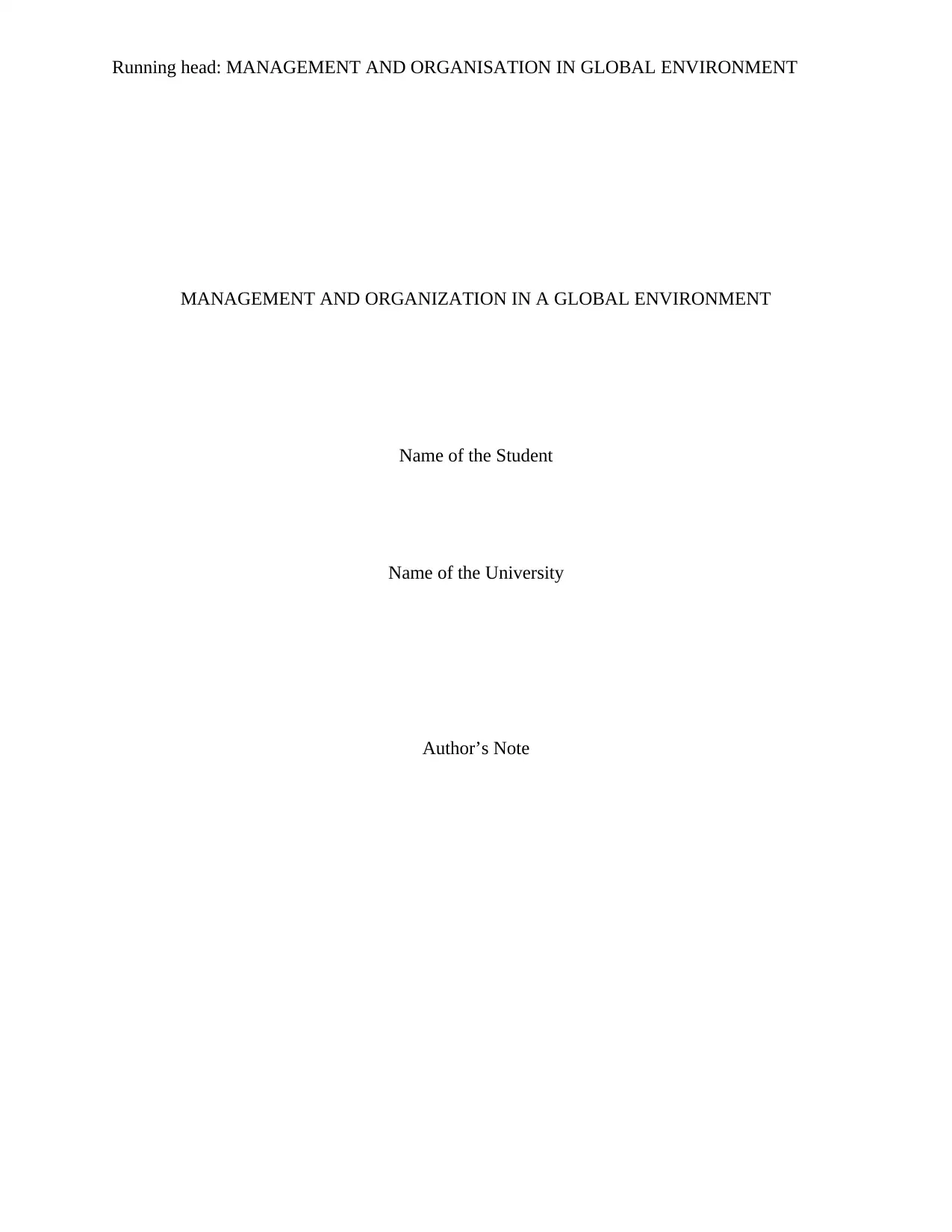
Running head: MANAGEMENT AND ORGANISATION IN GLOBAL ENVIRONMENT
MANAGEMENT AND ORGANIZATION IN A GLOBAL ENVIRONMENT
Name of the Student
Name of the University
Author’s Note
MANAGEMENT AND ORGANIZATION IN A GLOBAL ENVIRONMENT
Name of the Student
Name of the University
Author’s Note
Paraphrase This Document
Need a fresh take? Get an instant paraphrase of this document with our AI Paraphraser
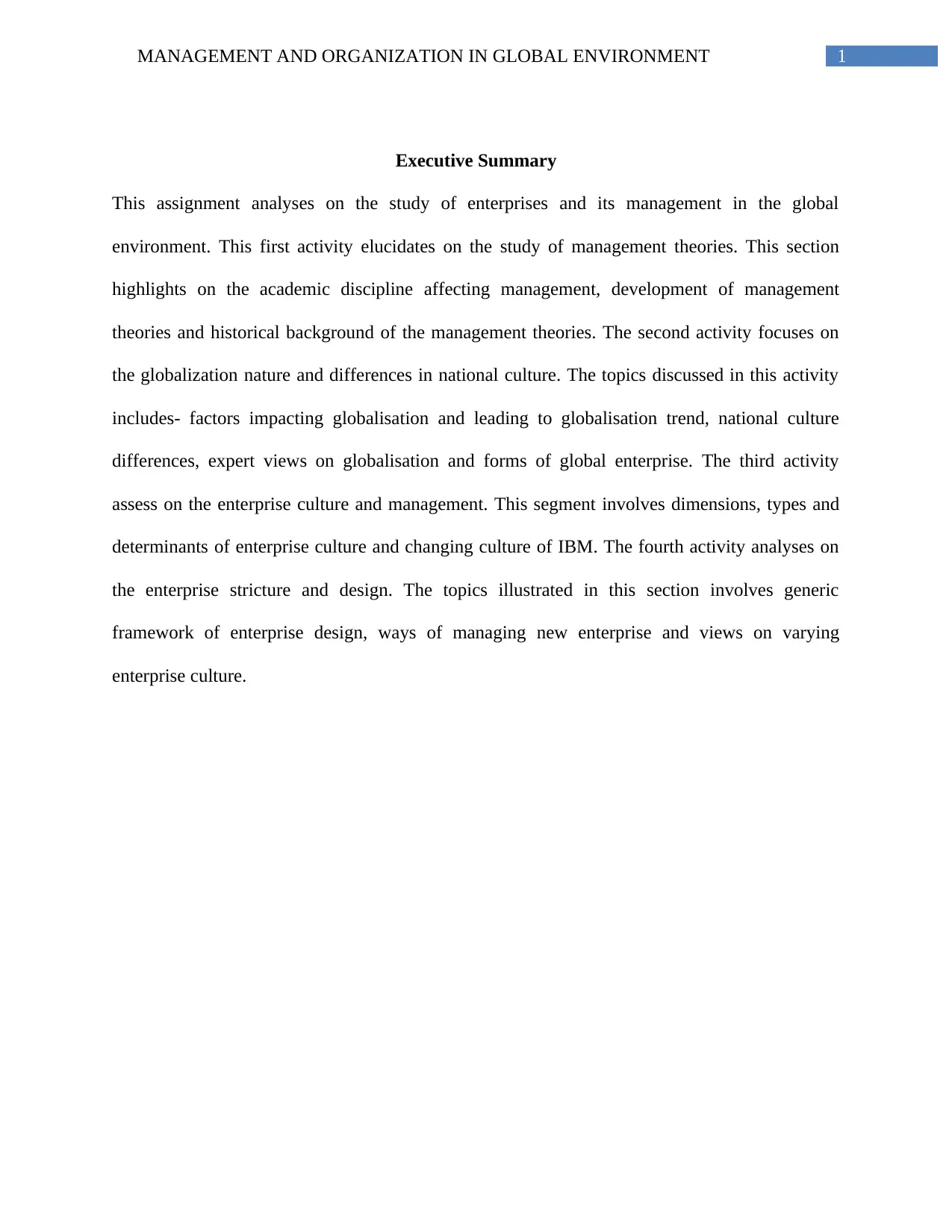
1MANAGEMENT AND ORGANIZATION IN GLOBAL ENVIRONMENT
Executive Summary
This assignment analyses on the study of enterprises and its management in the global
environment. This first activity elucidates on the study of management theories. This section
highlights on the academic discipline affecting management, development of management
theories and historical background of the management theories. The second activity focuses on
the globalization nature and differences in national culture. The topics discussed in this activity
includes- factors impacting globalisation and leading to globalisation trend, national culture
differences, expert views on globalisation and forms of global enterprise. The third activity
assess on the enterprise culture and management. This segment involves dimensions, types and
determinants of enterprise culture and changing culture of IBM. The fourth activity analyses on
the enterprise stricture and design. The topics illustrated in this section involves generic
framework of enterprise design, ways of managing new enterprise and views on varying
enterprise culture.
Executive Summary
This assignment analyses on the study of enterprises and its management in the global
environment. This first activity elucidates on the study of management theories. This section
highlights on the academic discipline affecting management, development of management
theories and historical background of the management theories. The second activity focuses on
the globalization nature and differences in national culture. The topics discussed in this activity
includes- factors impacting globalisation and leading to globalisation trend, national culture
differences, expert views on globalisation and forms of global enterprise. The third activity
assess on the enterprise culture and management. This segment involves dimensions, types and
determinants of enterprise culture and changing culture of IBM. The fourth activity analyses on
the enterprise stricture and design. The topics illustrated in this section involves generic
framework of enterprise design, ways of managing new enterprise and views on varying
enterprise culture.
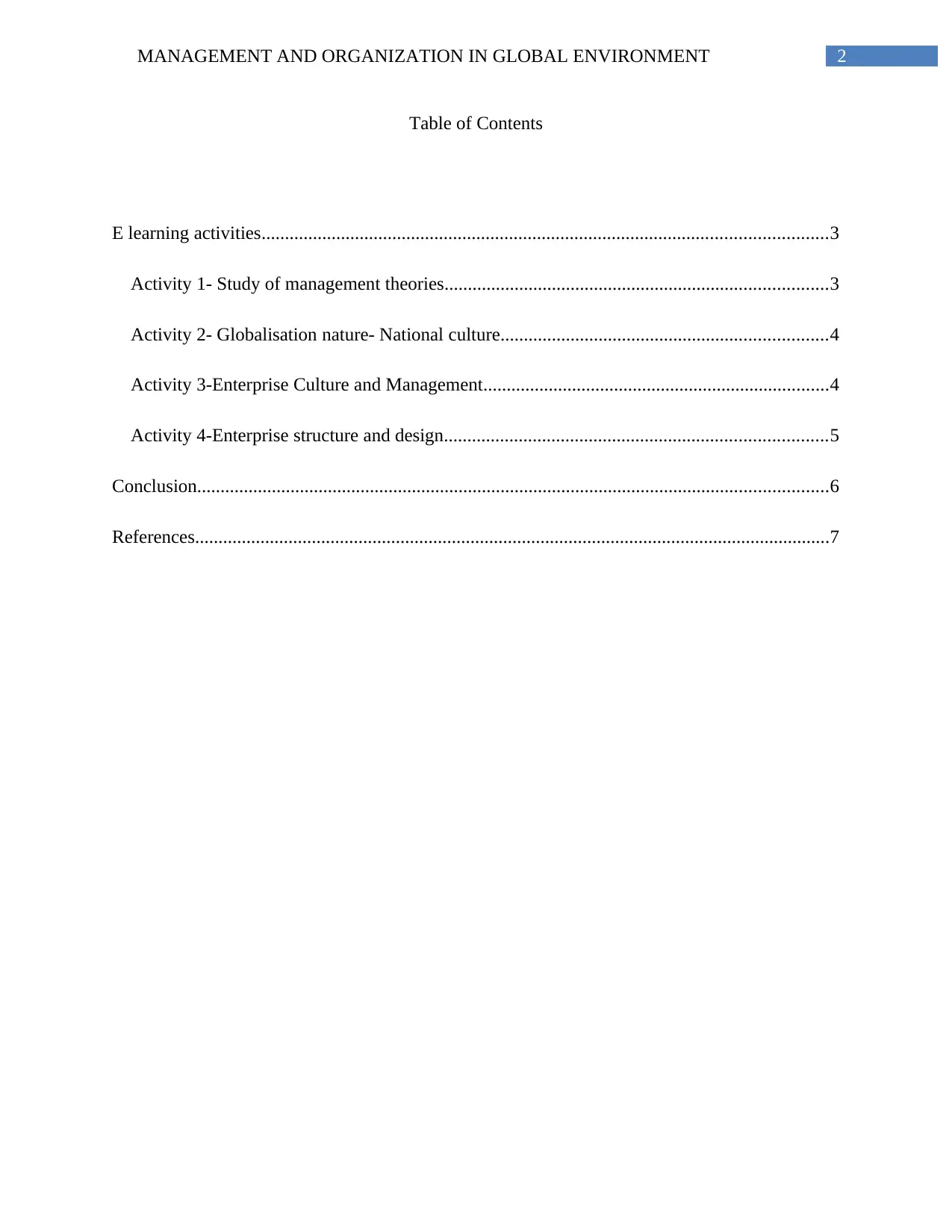
2MANAGEMENT AND ORGANIZATION IN GLOBAL ENVIRONMENT
Table of Contents
E learning activities.........................................................................................................................3
Activity 1- Study of management theories..................................................................................3
Activity 2- Globalisation nature- National culture......................................................................4
Activity 3-Enterprise Culture and Management..........................................................................4
Activity 4-Enterprise structure and design..................................................................................5
Conclusion.......................................................................................................................................6
References........................................................................................................................................7
Table of Contents
E learning activities.........................................................................................................................3
Activity 1- Study of management theories..................................................................................3
Activity 2- Globalisation nature- National culture......................................................................4
Activity 3-Enterprise Culture and Management..........................................................................4
Activity 4-Enterprise structure and design..................................................................................5
Conclusion.......................................................................................................................................6
References........................................................................................................................................7
⊘ This is a preview!⊘
Do you want full access?
Subscribe today to unlock all pages.

Trusted by 1+ million students worldwide
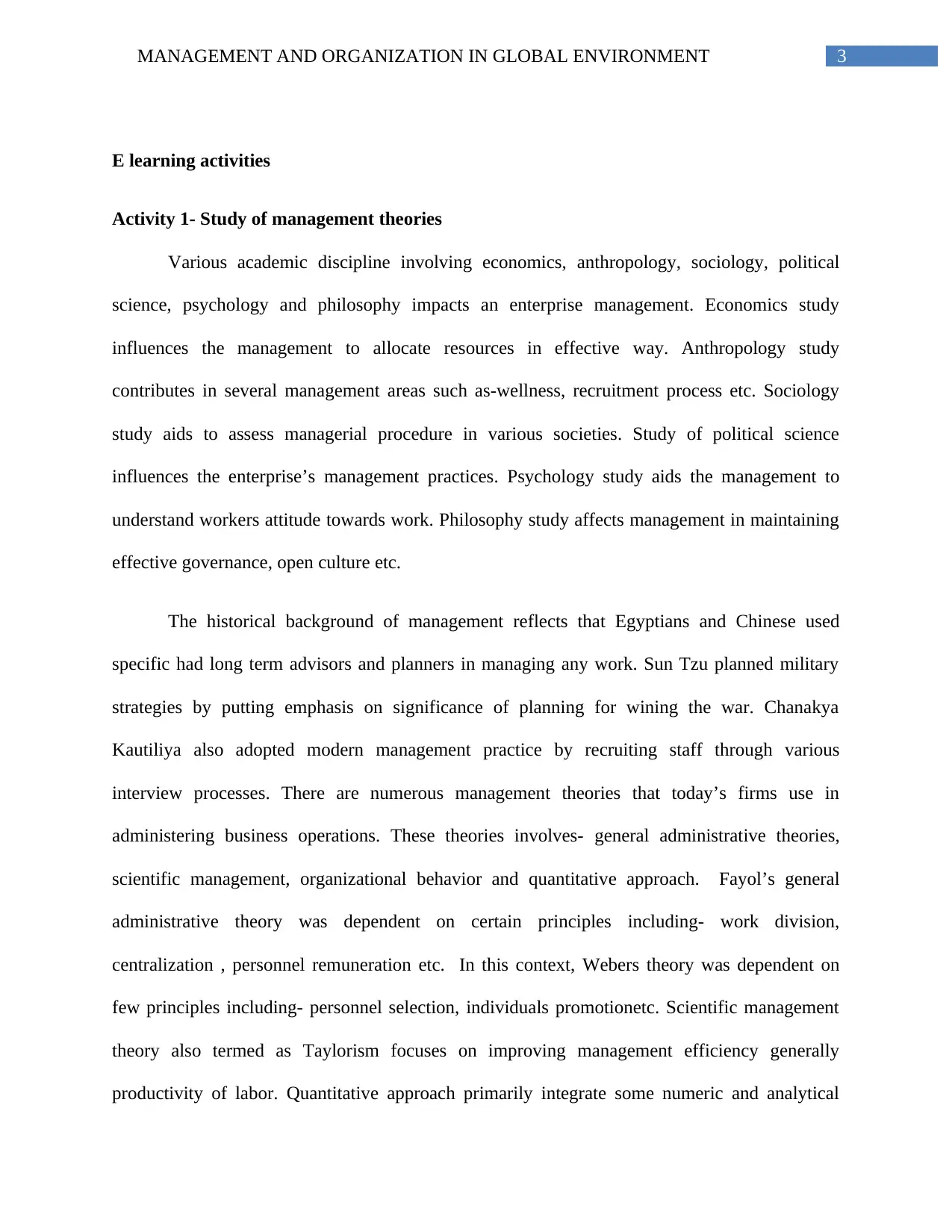
3MANAGEMENT AND ORGANIZATION IN GLOBAL ENVIRONMENT
E learning activities
Activity 1- Study of management theories
Various academic discipline involving economics, anthropology, sociology, political
science, psychology and philosophy impacts an enterprise management. Economics study
influences the management to allocate resources in effective way. Anthropology study
contributes in several management areas such as-wellness, recruitment process etc. Sociology
study aids to assess managerial procedure in various societies. Study of political science
influences the enterprise’s management practices. Psychology study aids the management to
understand workers attitude towards work. Philosophy study affects management in maintaining
effective governance, open culture etc.
The historical background of management reflects that Egyptians and Chinese used
specific had long term advisors and planners in managing any work. Sun Tzu planned military
strategies by putting emphasis on significance of planning for wining the war. Chanakya
Kautiliya also adopted modern management practice by recruiting staff through various
interview processes. There are numerous management theories that today’s firms use in
administering business operations. These theories involves- general administrative theories,
scientific management, organizational behavior and quantitative approach. Fayol’s general
administrative theory was dependent on certain principles including- work division,
centralization , personnel remuneration etc. In this context, Webers theory was dependent on
few principles including- personnel selection, individuals promotionetc. Scientific management
theory also termed as Taylorism focuses on improving management efficiency generally
productivity of labor. Quantitative approach primarily integrate some numeric and analytical
E learning activities
Activity 1- Study of management theories
Various academic discipline involving economics, anthropology, sociology, political
science, psychology and philosophy impacts an enterprise management. Economics study
influences the management to allocate resources in effective way. Anthropology study
contributes in several management areas such as-wellness, recruitment process etc. Sociology
study aids to assess managerial procedure in various societies. Study of political science
influences the enterprise’s management practices. Psychology study aids the management to
understand workers attitude towards work. Philosophy study affects management in maintaining
effective governance, open culture etc.
The historical background of management reflects that Egyptians and Chinese used
specific had long term advisors and planners in managing any work. Sun Tzu planned military
strategies by putting emphasis on significance of planning for wining the war. Chanakya
Kautiliya also adopted modern management practice by recruiting staff through various
interview processes. There are numerous management theories that today’s firms use in
administering business operations. These theories involves- general administrative theories,
scientific management, organizational behavior and quantitative approach. Fayol’s general
administrative theory was dependent on certain principles including- work division,
centralization , personnel remuneration etc. In this context, Webers theory was dependent on
few principles including- personnel selection, individuals promotionetc. Scientific management
theory also termed as Taylorism focuses on improving management efficiency generally
productivity of labor. Quantitative approach primarily integrate some numeric and analytical
Paraphrase This Document
Need a fresh take? Get an instant paraphrase of this document with our AI Paraphraser
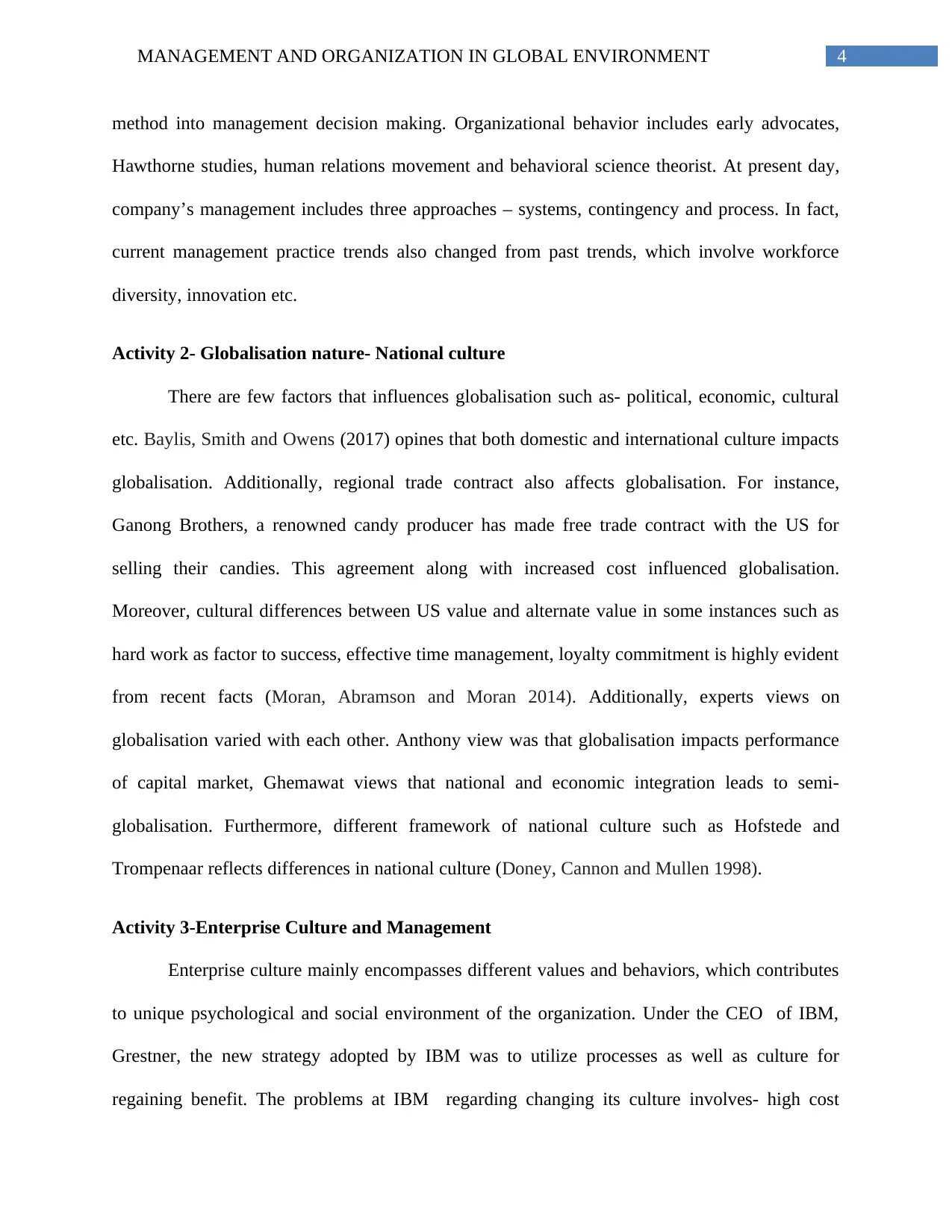
4MANAGEMENT AND ORGANIZATION IN GLOBAL ENVIRONMENT
method into management decision making. Organizational behavior includes early advocates,
Hawthorne studies, human relations movement and behavioral science theorist. At present day,
company’s management includes three approaches – systems, contingency and process. In fact,
current management practice trends also changed from past trends, which involve workforce
diversity, innovation etc.
Activity 2- Globalisation nature- National culture
There are few factors that influences globalisation such as- political, economic, cultural
etc. Baylis, Smith and Owens (2017) opines that both domestic and international culture impacts
globalisation. Additionally, regional trade contract also affects globalisation. For instance,
Ganong Brothers, a renowned candy producer has made free trade contract with the US for
selling their candies. This agreement along with increased cost influenced globalisation.
Moreover, cultural differences between US value and alternate value in some instances such as
hard work as factor to success, effective time management, loyalty commitment is highly evident
from recent facts (Moran, Abramson and Moran 2014). Additionally, experts views on
globalisation varied with each other. Anthony view was that globalisation impacts performance
of capital market, Ghemawat views that national and economic integration leads to semi-
globalisation. Furthermore, different framework of national culture such as Hofstede and
Trompenaar reflects differences in national culture (Doney, Cannon and Mullen 1998).
Activity 3-Enterprise Culture and Management
Enterprise culture mainly encompasses different values and behaviors, which contributes
to unique psychological and social environment of the organization. Under the CEO of IBM,
Grestner, the new strategy adopted by IBM was to utilize processes as well as culture for
regaining benefit. The problems at IBM regarding changing its culture involves- high cost
method into management decision making. Organizational behavior includes early advocates,
Hawthorne studies, human relations movement and behavioral science theorist. At present day,
company’s management includes three approaches – systems, contingency and process. In fact,
current management practice trends also changed from past trends, which involve workforce
diversity, innovation etc.
Activity 2- Globalisation nature- National culture
There are few factors that influences globalisation such as- political, economic, cultural
etc. Baylis, Smith and Owens (2017) opines that both domestic and international culture impacts
globalisation. Additionally, regional trade contract also affects globalisation. For instance,
Ganong Brothers, a renowned candy producer has made free trade contract with the US for
selling their candies. This agreement along with increased cost influenced globalisation.
Moreover, cultural differences between US value and alternate value in some instances such as
hard work as factor to success, effective time management, loyalty commitment is highly evident
from recent facts (Moran, Abramson and Moran 2014). Additionally, experts views on
globalisation varied with each other. Anthony view was that globalisation impacts performance
of capital market, Ghemawat views that national and economic integration leads to semi-
globalisation. Furthermore, different framework of national culture such as Hofstede and
Trompenaar reflects differences in national culture (Doney, Cannon and Mullen 1998).
Activity 3-Enterprise Culture and Management
Enterprise culture mainly encompasses different values and behaviors, which contributes
to unique psychological and social environment of the organization. Under the CEO of IBM,
Grestner, the new strategy adopted by IBM was to utilize processes as well as culture for
regaining benefit. The problems at IBM regarding changing its culture involves- high cost
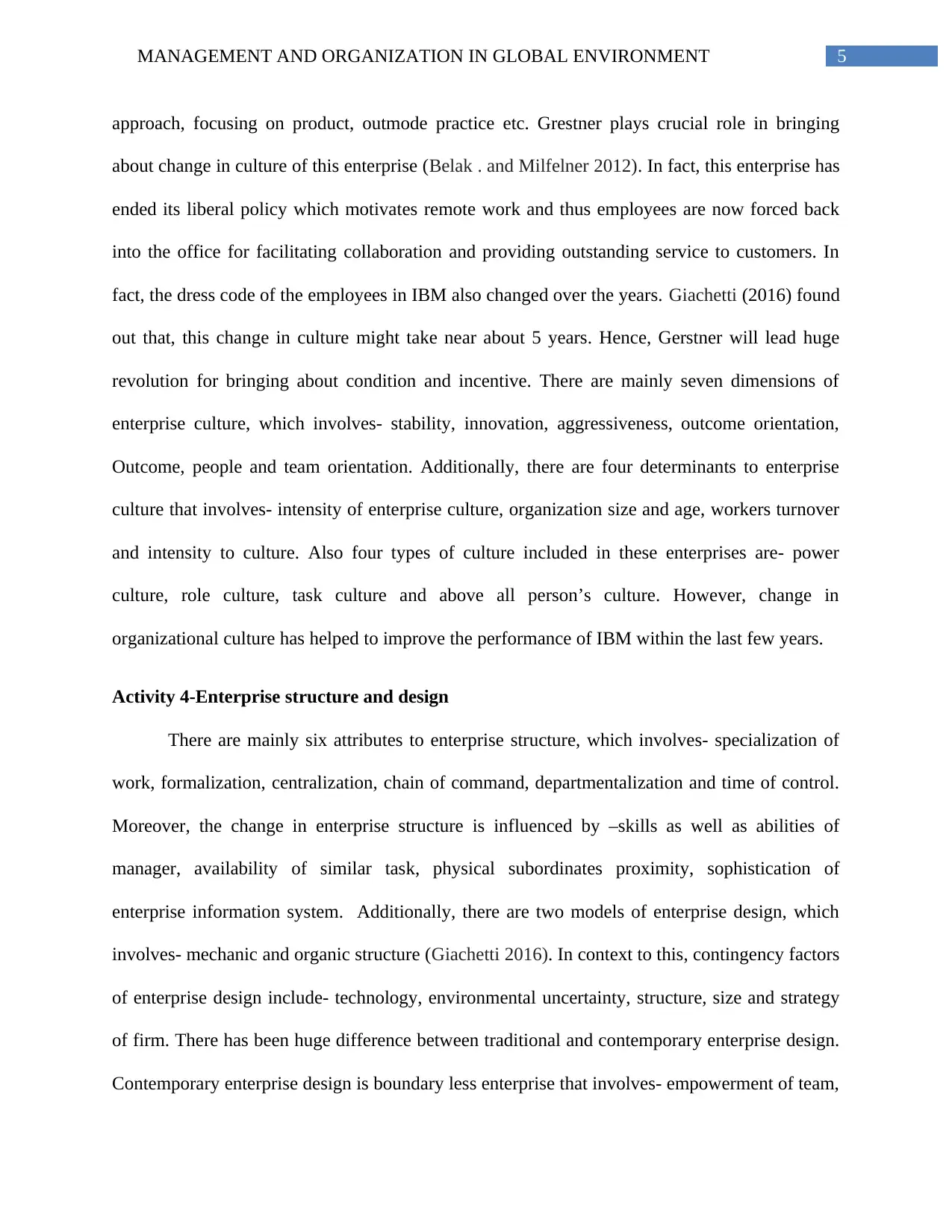
5MANAGEMENT AND ORGANIZATION IN GLOBAL ENVIRONMENT
approach, focusing on product, outmode practice etc. Grestner plays crucial role in bringing
about change in culture of this enterprise (Belak . and Milfelner 2012). In fact, this enterprise has
ended its liberal policy which motivates remote work and thus employees are now forced back
into the office for facilitating collaboration and providing outstanding service to customers. In
fact, the dress code of the employees in IBM also changed over the years. Giachetti (2016) found
out that, this change in culture might take near about 5 years. Hence, Gerstner will lead huge
revolution for bringing about condition and incentive. There are mainly seven dimensions of
enterprise culture, which involves- stability, innovation, aggressiveness, outcome orientation,
Outcome, people and team orientation. Additionally, there are four determinants to enterprise
culture that involves- intensity of enterprise culture, organization size and age, workers turnover
and intensity to culture. Also four types of culture included in these enterprises are- power
culture, role culture, task culture and above all person’s culture. However, change in
organizational culture has helped to improve the performance of IBM within the last few years.
Activity 4-Enterprise structure and design
There are mainly six attributes to enterprise structure, which involves- specialization of
work, formalization, centralization, chain of command, departmentalization and time of control.
Moreover, the change in enterprise structure is influenced by –skills as well as abilities of
manager, availability of similar task, physical subordinates proximity, sophistication of
enterprise information system. Additionally, there are two models of enterprise design, which
involves- mechanic and organic structure (Giachetti 2016). In context to this, contingency factors
of enterprise design include- technology, environmental uncertainty, structure, size and strategy
of firm. There has been huge difference between traditional and contemporary enterprise design.
Contemporary enterprise design is boundary less enterprise that involves- empowerment of team,
approach, focusing on product, outmode practice etc. Grestner plays crucial role in bringing
about change in culture of this enterprise (Belak . and Milfelner 2012). In fact, this enterprise has
ended its liberal policy which motivates remote work and thus employees are now forced back
into the office for facilitating collaboration and providing outstanding service to customers. In
fact, the dress code of the employees in IBM also changed over the years. Giachetti (2016) found
out that, this change in culture might take near about 5 years. Hence, Gerstner will lead huge
revolution for bringing about condition and incentive. There are mainly seven dimensions of
enterprise culture, which involves- stability, innovation, aggressiveness, outcome orientation,
Outcome, people and team orientation. Additionally, there are four determinants to enterprise
culture that involves- intensity of enterprise culture, organization size and age, workers turnover
and intensity to culture. Also four types of culture included in these enterprises are- power
culture, role culture, task culture and above all person’s culture. However, change in
organizational culture has helped to improve the performance of IBM within the last few years.
Activity 4-Enterprise structure and design
There are mainly six attributes to enterprise structure, which involves- specialization of
work, formalization, centralization, chain of command, departmentalization and time of control.
Moreover, the change in enterprise structure is influenced by –skills as well as abilities of
manager, availability of similar task, physical subordinates proximity, sophistication of
enterprise information system. Additionally, there are two models of enterprise design, which
involves- mechanic and organic structure (Giachetti 2016). In context to this, contingency factors
of enterprise design include- technology, environmental uncertainty, structure, size and strategy
of firm. There has been huge difference between traditional and contemporary enterprise design.
Contemporary enterprise design is boundary less enterprise that involves- empowerment of team,
⊘ This is a preview!⊘
Do you want full access?
Subscribe today to unlock all pages.

Trusted by 1+ million students worldwide
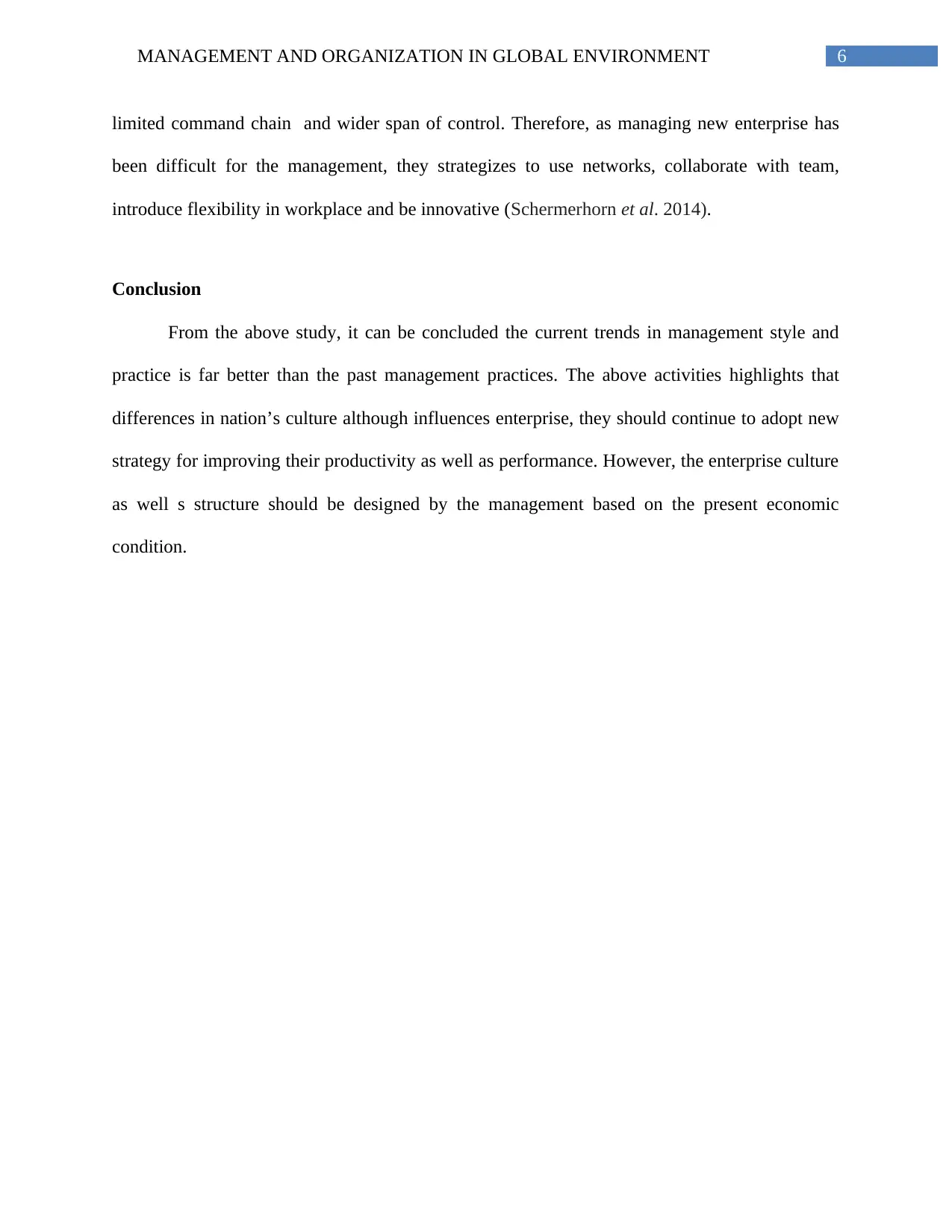
6MANAGEMENT AND ORGANIZATION IN GLOBAL ENVIRONMENT
limited command chain and wider span of control. Therefore, as managing new enterprise has
been difficult for the management, they strategizes to use networks, collaborate with team,
introduce flexibility in workplace and be innovative (Schermerhorn et al. 2014).
Conclusion
From the above study, it can be concluded the current trends in management style and
practice is far better than the past management practices. The above activities highlights that
differences in nation’s culture although influences enterprise, they should continue to adopt new
strategy for improving their productivity as well as performance. However, the enterprise culture
as well s structure should be designed by the management based on the present economic
condition.
limited command chain and wider span of control. Therefore, as managing new enterprise has
been difficult for the management, they strategizes to use networks, collaborate with team,
introduce flexibility in workplace and be innovative (Schermerhorn et al. 2014).
Conclusion
From the above study, it can be concluded the current trends in management style and
practice is far better than the past management practices. The above activities highlights that
differences in nation’s culture although influences enterprise, they should continue to adopt new
strategy for improving their productivity as well as performance. However, the enterprise culture
as well s structure should be designed by the management based on the present economic
condition.
Paraphrase This Document
Need a fresh take? Get an instant paraphrase of this document with our AI Paraphraser
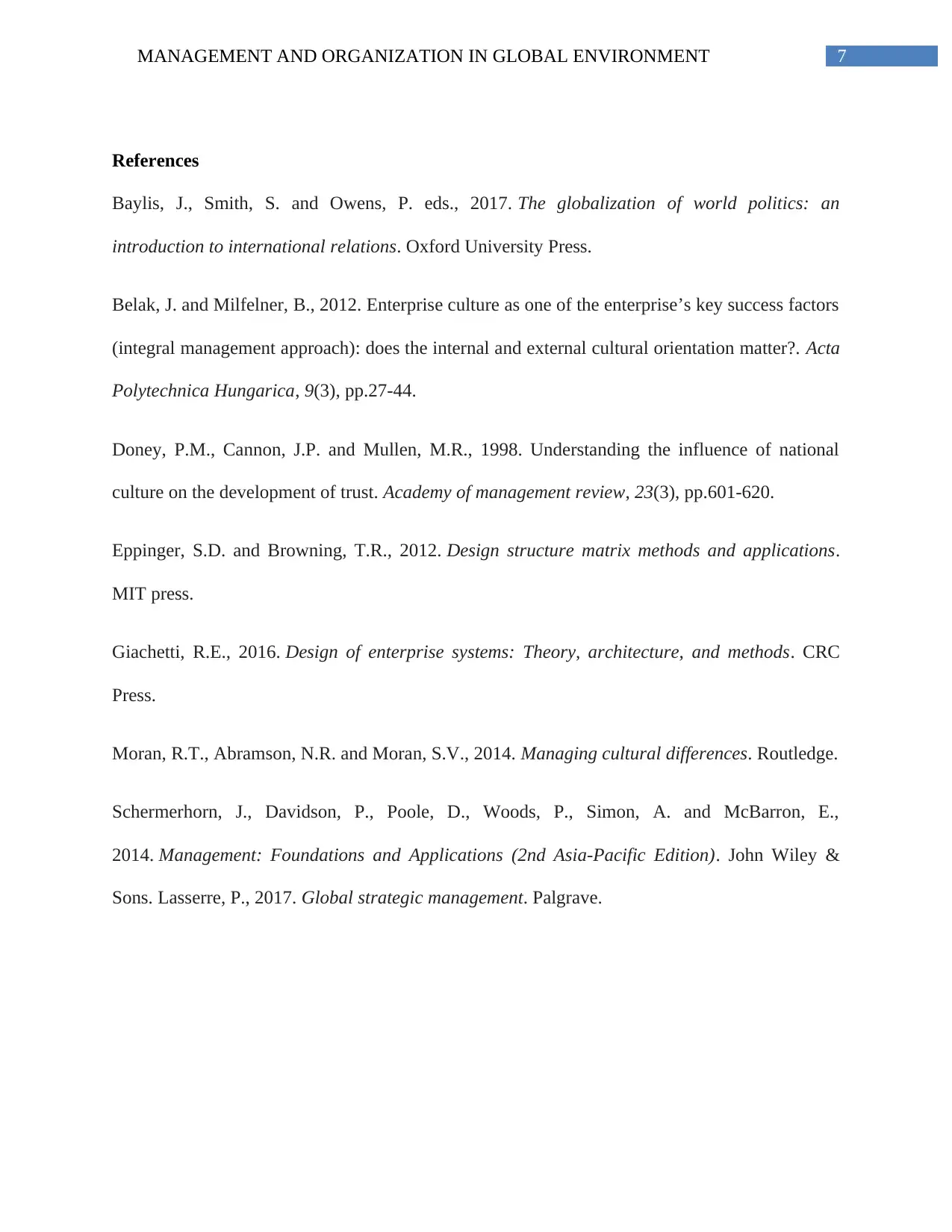
7MANAGEMENT AND ORGANIZATION IN GLOBAL ENVIRONMENT
References
Baylis, J., Smith, S. and Owens, P. eds., 2017. The globalization of world politics: an
introduction to international relations. Oxford University Press.
Belak, J. and Milfelner, B., 2012. Enterprise culture as one of the enterprise’s key success factors
(integral management approach): does the internal and external cultural orientation matter?. Acta
Polytechnica Hungarica, 9(3), pp.27-44.
Doney, P.M., Cannon, J.P. and Mullen, M.R., 1998. Understanding the influence of national
culture on the development of trust. Academy of management review, 23(3), pp.601-620.
Eppinger, S.D. and Browning, T.R., 2012. Design structure matrix methods and applications.
MIT press.
Giachetti, R.E., 2016. Design of enterprise systems: Theory, architecture, and methods. CRC
Press.
Moran, R.T., Abramson, N.R. and Moran, S.V., 2014. Managing cultural differences. Routledge.
Schermerhorn, J., Davidson, P., Poole, D., Woods, P., Simon, A. and McBarron, E.,
2014. Management: Foundations and Applications (2nd Asia-Pacific Edition). John Wiley &
Sons. Lasserre, P., 2017. Global strategic management. Palgrave.
References
Baylis, J., Smith, S. and Owens, P. eds., 2017. The globalization of world politics: an
introduction to international relations. Oxford University Press.
Belak, J. and Milfelner, B., 2012. Enterprise culture as one of the enterprise’s key success factors
(integral management approach): does the internal and external cultural orientation matter?. Acta
Polytechnica Hungarica, 9(3), pp.27-44.
Doney, P.M., Cannon, J.P. and Mullen, M.R., 1998. Understanding the influence of national
culture on the development of trust. Academy of management review, 23(3), pp.601-620.
Eppinger, S.D. and Browning, T.R., 2012. Design structure matrix methods and applications.
MIT press.
Giachetti, R.E., 2016. Design of enterprise systems: Theory, architecture, and methods. CRC
Press.
Moran, R.T., Abramson, N.R. and Moran, S.V., 2014. Managing cultural differences. Routledge.
Schermerhorn, J., Davidson, P., Poole, D., Woods, P., Simon, A. and McBarron, E.,
2014. Management: Foundations and Applications (2nd Asia-Pacific Edition). John Wiley &
Sons. Lasserre, P., 2017. Global strategic management. Palgrave.
1 out of 8
Related Documents
Your All-in-One AI-Powered Toolkit for Academic Success.
+13062052269
info@desklib.com
Available 24*7 on WhatsApp / Email
![[object Object]](/_next/static/media/star-bottom.7253800d.svg)
Unlock your academic potential
Copyright © 2020–2025 A2Z Services. All Rights Reserved. Developed and managed by ZUCOL.




